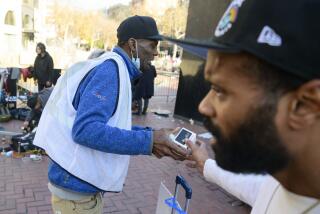How black-market OxyContin spurred a town’s descent into crime, addiction and heartbreak
- Share via
Reporting from Everett, Wash. — For years, Jevon “Goldie” Lawson dealt crack on the steps of a 7-Eleven in a rough part of this blue-collar town. He smoked the rocks he didn’t sell and often appeared as strung out as his customers.
But in 2008, he moved into a $400,000 house, started driving a champagne-colored Humvee, and made himself the star act of his own hip-hop label. He abandoned the crack business. Found something better, he told associates.
What he found was OxyContin from Southern California, where organized drug rings were colluding with rogue doctors and pharmacies to obtain enormous quantities of the drug.
Illicit OxyContin devastated the entire Everett region. At the height of the drug’s popularity, it was a factor in more than half of the crimes in Snohomish County. Abuse of the drug touched off an epidemic of painkiller and heroin addiction, which continues to this day.
The crisis swept up many young people, such as Katie McKnight, the daughter of an Everett physician whose dependency outlasted seven trips to rehab, and Brandon Smith, who lost a promising career at Nintendo and, ultimately, his freedom to OxyContin.
Authorities in Everett knew much of the drug was coming from traffickers in the Los Angeles area, but they were unable to determine how pills were getting on the black market. A Times review of court records and law enforcement reports suggests that several people who sent OxyContin from Southern California to Lawson in Everett were buying pills from Lake Medical, a clinic near MacArthur Park that was a front for a drug ring.
The records, along with interviews of law enforcement officials, indicate that Inland Empire Crips gang members drove bags of OxyContin north on Interstate 5 to Washington State and sent couriers aboard planes to Seattle with pills strapped to their bodies.
At the time OxyContin was ravaging Everett, Purdue Pharma, the maker of OxyContin, was tracking the voluminous prescriptions written by Lake Medical’s doctors as well as the extraordinary quantities of pills ordered by corrupt pharmacies filling those prescriptions. It did not track Lake Medical pills to their final destinations, however.
It wasn’t until years later, after authorities brought down the ring, that Purdue shared the information with law enforcement. By then, 1.1 million pills had spilled onto the black market.
***
Everett, a city of 100,000, hugs Port Gardner Bay about halfway between Seattle and the Canadian border. Ferries crisscross the blue-gray waters of Puget Sound; the snowcapped Cascades rise behind the modest skyline.
A thriving mill town at the turn of the 20th century, Everett has seen its fortunes rise and fall with various industries -- shipbuilding, lumber, iron and canneries. The largest employers today are Boeing, which assembles four types of airliners at a plant along Interstate 5, and the U.S. Navy, which has a deep-water port on the north end of town.
The region had long grappled with methamphetamine abuse. But with the California pills flowing to Lawson, OxyContin became the community’s most pressing drug problem.
Lawson wasn’t shy about the source of his new wealth. He wore a pendant necklace with a map of the West Coast in diamonds and a trail of gems the color of 80-milligram OxyContin connecting Los Angeles and Washington state.
He sold the 80-milligram tablets — the maximum-strength pill favored by addicts — in bulk to local gangs that used small-time dealers to peddle them for up to $80 a piece.
Dealers sold pills in parks, outside grocery stores and at car washes. The aluminum foil that addicts used to smoke the pills littered parking lots and sidewalks. Some grocery stores gave away foil squares to discourage the rampant shoplifting of Reynolds Wrap.
Addicts burglarized homes, picked pockets, stole identities, robbed businesses and prostituted themselves. Young women in pasties and thongs offered sexual favors alongside lattes at a proliferation of drive-in “bikini” espresso stands.
OxyContin seemed to attract people with no criminal records and stable homes, jobs, and families.
“They were a segment of society you would never have anticipated,” said Coleen St. Clair, a former Snohomish County prosecuting attorney who worked in the narcotics unit.
***
Katie McKnight was smart and beautiful, a gifted athlete and the daughter of an Everett internist. A friend had given her a pill in 2006 during her first year at a local community college and, in the words of her mother, Mary, “that was it.”
To buy pills, the young woman stole her sister’s graduation money, her parents’ checkbook and, twice, her mother’s engagement ring. She tried to snatch a woman’s purse in a grocery store parking lot, shoplifted and, for a time, worked as a stripper.
Her father was familiar with OxyContin, but in his many years at a busy city clinic, he had never come across a patient who required a maximum-strength dose. He struggled to comprehend how his daughter was getting her hands on large numbers of 80-milligram tablets.
“It seemed so completely outside the realm of possibility,” Robert McKnight said.
When Lawson began dealing OxyContin in Everett, the 24-year-old had finished a year in prison for theft and her parents were doing everything they could to help her stay sober. They let her move back into her childhood bedroom, drove her to 12-step meetings and supported her efforts to find a job.
But Katie relapsed, often spending nights at a motel where, the authorities said, dealers connected to Lawson sold 80s in the parking lot.
On one car ride to a treatment center, her mother recalled, Katie studied her reflection in the visor mirror. After several long moments, she said quietly to herself, “I am so broken.”
***
To Brandon Smith, who worked in marketing for Nintendo, OxyContin seemed less a dangerous narcotic than a status symbol. The popular crowd openly smoked the “green beans” on pieces of foil.
“It was socially acceptable,” said Smith, who lived near Everett. “It was almost the new weed.”
Smith became addicted, then got clean for a time. But in January 2009, at the age of 24, he relapsed. The flood of OxyContin into Everett had driven down prices and more people than ever were selling.
By the summer of 2009, Smith had a $150-a-day habit. He’d been forced out of his job for stealing. He’d spent his 401(k) and sold his belongings. On a July afternoon, he was out of cash and going into withdrawal. He saw only one way out. He walked into a tanning salon near Everett and pointed a gun at a clerk.
“Give me all your money,” he told her.
He committed another robbery later that day. And the next. And the next. The cashiers didn’t notice the gun was a fake. What they did remember was that the man holding it was polite and apologized as he left.
Two weeks into the 2009 spree, a local TV news program broadcast surveillance video of the “Tanning Salon Bandit.” Smith’s mother, watching at home, immediately recognized her son and phoned police.
Officers surrounded him as he left his apartment the next morning. As they trained their weapons on him, he would later recall, he felt a brief sense of confusion. “It’s just me, guys,” he remembered thinking. “It’s just Brandon.”
Smith confessed to at least 17 robberies. He was sentenced to 14 years in state prison, where he remains today.
“I never meant to hurt anyone,” he told detectives. “One thing led to another.”
***
Working OxyContin cases for the Snohomish Regional Drug Task Force, Det. Nicole Richardson spent many of her days talking to addicts and their families.
“It impacted probably every aspect of the local community,” Richardson recalled. “A couple of individuals with the right connections in California flooded the Snohomish County market and unfortunately made a huge problem.”
Investigators in Everett arrested Jevon Lawson in 2010, about the same time an L.A. drug task force was closing in on members of the Lake Medical ring. Federal prosecutors in L.A. won convictions of the clinic leaders while their counterparts in Seattle successfully prosecuted Lawson and several Californians supplying him with OxyContin.
A defendant in one of the Washington state cases, a San Bernardino woman who pleaded guilty to laundering nearly $1 million as part of a conspiracy to supply OxyContin to Lawson, had purchased large quantities of OxyContin pills from Lake Medical, according to a DEA analyst’s report and an informant’s statement to authorities.
The prosecutors did not allege in court that the OxyContin in Everett came specifically from the Lake Medical ring, and internal Purdue emails reviewed by The Times did not indicate that Purdue knew of a connection.
Ultimately, the authorities in Everett built their case against Lawson and his associates with old-fashioned police work — surveilling drug spots, working informants and carrying out buy-and-bust operations. He pleaded guilty to federal drug charges in 2011 and is serving an 8-year prison term.
In August 2010, two years after the OxyContin crisis began in Everett, Purdue introduced a new tablet that was more difficult to turn into powder. Addicts could no longer smoke the pills, but many of them moved to heroin, which is chemically similar and cheaper.
Dealers who had been selling heroin to the same small group of drug users for years suddenly found themselves with a booming new clientele of, as one former dealer from Everett recalled, “upper- and middle-class children.” Today, heroin addiction is a public health crisis in Snohomish County; more than 40 residents fatally overdose each year.
Katie McKnight had used heroin and other drugs when she couldn’t afford OxyContin, but after the pill reformulation, she became a full-time intravenous heroin user.
In the fall of 2011, she was living in a squalid apartment with a drug dealer boyfriend and praying for sobriety.
“God please give me some kind of way to get into detox to get the help I need to kick the dependence and have my life back,” she wrote in pink cursive in her journal on Oct. 1, 2011. “I seriously feel like I’m slowly dying. I need help!”
Nineteen days later, she overdosed in her apartment. Her parents stood outside in the cold, misty darkness for an hour while paramedics worked to revive her. Finally, a police officer came out and told them their daughter was gone.
The McKnights keep her ashes in an urn on their nightstand. Robert McKnight often wakes thinking about his daughter.
“You kind of look back and ask yourself, “What if the OxyContin was not there?’” he said.
More to Read
Sign up for Essential California
The most important California stories and recommendations in your inbox every morning.
You may occasionally receive promotional content from the Los Angeles Times.













